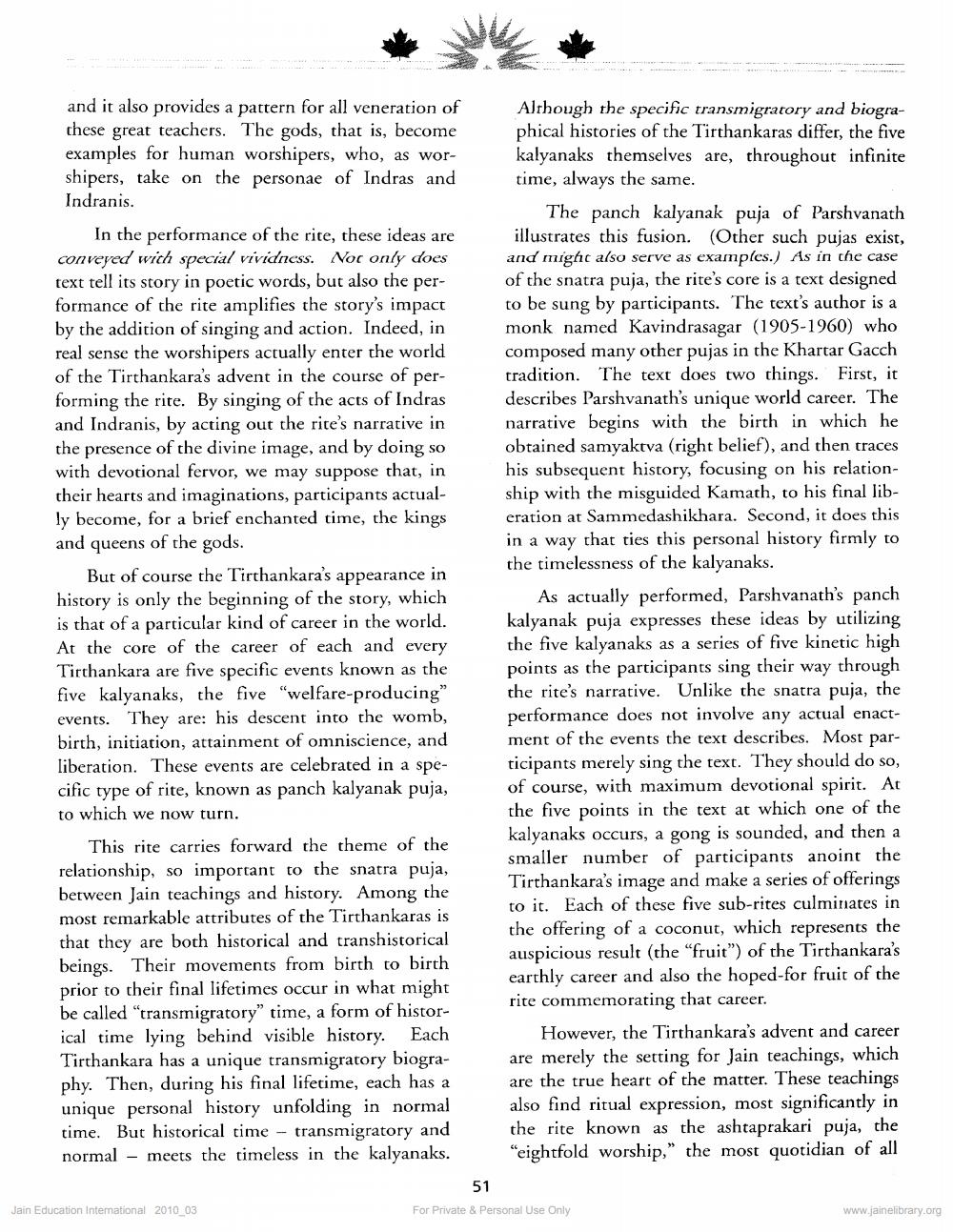________________
and it also provides a pattern for all veneration of these great teachers. The gods, that is, become examples for human worshipers, who, as wor shipers, take on the personae of Indras and Indranis.
In the performance of the rite, these ideas are conveyed with special vividness. Not only does text tell its story in poetic words, but also the performance of the rite amplifies the story's impact by the addition of singing and action. Indeed, in real sense the worshipers actually enter the world. of the Tirthankara's advent in the course of performing the rite. By singing of the acts of Indras and Indranis, by acting out the rite's narrative in the presence of the divine image, and by doing so with devotional fervor, we may suppose that, in their hearts and imaginations, participants actually become, for a brief enchanted time, the kings and queens of the gods.
But of course the Tirthankara's appearance in history is only the beginning of the story, which is that of a particular kind of career in the world. At the core of the career of each and every Tirthankara are five specific events known as the five kalyanaks, the five "welfare-producing" events. They are: his descent into the womb, birth, initiation, attainment of omniscience, and liberation. These events are celebrated in a specific type of rite, known as panch kalyanak puja, to which we now turn.
This rite carries forward the theme of the relationship, so important to the snatra puja, between Jain teachings and history. Among the most remarkable attributes of the Tirthankaras is that they are both historical and transhistorical beings. Their movements from birth to birth prior to their final lifetimes occur in what might be called "transmigratory" time, a form of historical time lying behind visible history. Each Tirthankara has a unique transmigratory biography. Then, during his final lifetime, each has at unique personal history unfolding in normal time. But historical time transmigratory and normal meets the timeless in the kalyanaks.
Jain Education International 2010_03
Although the specific transmigratory and biogra phical histories of the Tirthankaras differ, the five kalyanaks themselves are, throughout infinite time, always the same.
The panch kalyanak puja of Parshvanath illustrates this fusion. (Other such pujas exist, and might also serve as examples.) As in the case of the snatra puja, the rite's core is a text designed to be sung by participants. The text's author is a monk named Kavindrasagar (1905-1960) who composed many other pujas in the Khartar Gacch tradition. The text does two things. First, it describes Parshvanath's unique world career. The narrative begins with the birth in which he obtained samyaktva (right belief), and then traces his subsequent history, focusing on his relationship with the misguided Kamath, to his final liberation at Sammedashikhara. Second, it does this in a way that ties this personal history firmly to the timelessness of the kalyanaks.
As actually performed, Parshvanath's panch kalyanak puja expresses these ideas by utilizing the five kalyanaks as a series of five kinetic high points as the participants sing their way through the rite's narrative. Unlike the snatra puja, the performance does not involve any actual enactment of the events the text describes. Most participants merely sing the text. They should do so, of course, with maximum devotional spirit. At the five points in the text at which one of the kalyanaks occurs, a gong is sounded, and then a smaller number of participants anoint the Tirthankara's image and make a series of offerings to it. Each of these five sub-rites culminates in the offering of a coconut, which represents the auspicious result (the "fruit") of the Tirthankara's earthly career and also the hoped-for fruit of the rite commemorating that career.
However, the Tirthankara's advent and career are merely the setting for Jain teachings, which are the true heart of the matter. These teachings also find ritual expression, most significantly in the rite known as the ashtaprakari puja, the "eightfold worship," the most quotidian of all
51
For Private & Personal Use Only
www.jainelibrary.org




